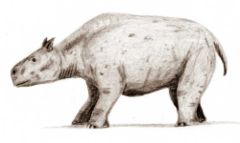- Meridiungulata
-
Meridiungulata 
Toxodon platensis Scientific classification Kingdom: Animalia Phylum: Chordata Class: Mammalia Infraclass: Eutheria Superorder: Laurasiatheria ? (unranked): †Meridiungulata
McKenna, 1975Orders - †Pyrotheria (disputed)
- †Astrapotheria (disputed)
- †Notoungulata
- †Litopterna
Meridiungulata is an extinct clade with the rank of cohort or super-order, containing the South-American ungulates: Pyrotheria (possibly including Xenungulata), Astrapotheria, Notoungulata and Litopterna. Meridiungulata may have originated in South America from a North American condylarth ancestor[1], and they may be members of the clade Laurasiatheria, related to other ungulates including artiodactyls and perissodactyls.[2] It is, however, entirely possible the Meridiungulata are actually part of a different macro-group of placental mammals called Atlantogenata. [3]
Much of the evolution of meridiungulates occurred in isolation from other ungulates, a great example of convergent evolution. However, the argument that meridiungulates are related to artiodactyls and perissodactyls will remain tenuous unless DNA is found to confirm this relationship. Some paleontologists have also challenged the monophyly of Meridiungulata by suggesting that pyrotheres may be more closely related to other mammals such as Embrithopoda (an African order that may be related to elephants) than to other South American ungulates.[4]
Most litopterns and notoungulates died out following the invasion of South America by North American ungulates and predators during the Great American Interchange; a few species from both orders survived until the end-Pleistocene extinctions.
References
- ^ Muizon, C.de and Cifelli, R.L. (2000). "The "condylarths" (archaic Ungulata, Mammalia) from the early Paleocene of Tiupampa (Bolivia): implications on the origin of the South American ungulates". Geodiversitas 22 (1): 47–150.
- ^ Hunter, J.P. and Janis, C.M. (2006). "Spiny Norman in the Garden of Eden? Dispersal and early biogeography of Placentalia". Journal of Mammalian Evolution 13 (2): 89–123. doi:10.1007/s10914-006-9006-6.
- ^ "Snorki the giant's friends and relatives", Tetrapod Zoology, 8 February 2008
- ^ Shockey, B.J., and Anaya, F. (2004). "Pyrotherium macfaddeni, sp. nov. (late Oligocene, Bolivia) and the pedal morphology of pyrotheres". Journal of Vertebrate Paleontology 24 (2): 481–488. doi:10.1671/2521.

This prehistoric mammal-related article is a stub. You can help Wikipedia by expanding it.
